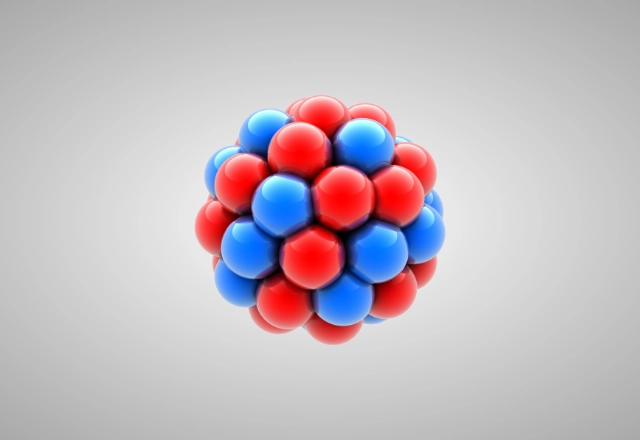Development of the atomic model

Aims of this page
After studying this page, you should be able to describe how the atomic model has changed over time, including:
- Dalton’s simple model
- Thomson’s plum pudding model
- the Geiger-Marsden alpha scattering experiment
- Rutherford’s nuclear model
- Bohr’s shell model
- the discovery of subatomic particles.
Dalton's model
John Dalton (1766 – 1844) was an English scientist who developed an atomic theory early in the 19th century. The technology did not exist then to investigate atoms in detail, so he imagined them as very tiny balls. Dalton also devised some ideas that are similar to scientific ideas today:
- elements are made of atoms
- the atoms of an element are all the same, but different from the atoms of other elements
- atoms cannot be made, broken down or destroyed.
He also devised chemical ideas about compounds and reactions:
- atoms of different elements join together in whole-number ratios to make compounds
- atoms in substances are separated, joined or rearranged in chemical reactions.
The plum pudding model
J.J. Thomson (1856 – 1940) was a British physicist who discovered the electron in 1897. He knew that:
- atoms contain electrons
- electrons are negatively charged
- atoms have no overall electric charge.
Joseph John Thomson was a talented scientist who began his university studies when he was just 14. Later in his career, Ernest Rutherford became one of his students.
Thomson devised a model of the atom in which electrons are embedded in a sphere of positive charge. This model became known as the plum pudding model because it resembled a type of dessert containing dried fruit.
Remember: at this time, no-one knew that an atom has a nucleus.

The alpha scattering experiment
Ernest Rutherford (1871 – 1937) was a New Zealand physicist who discovered alpha radiation. By 1907 he knew that alpha particles are positively charged helium ions. Rutherford wanted to find out more about their properties, so he asked his colleagues Hans Geiger and Ernest Marsden to carry out an experiment.
The scientists aimed a beam of alpha particles at very thin gold foil. The foil was surrounded by a fluorescent screen that flashed when an alpha particle hit it. Working in the dark, Geiger and Marsden recorded the numbers and positions of these flashes.
Atoms are neutral overall.
Positively charged ions form when atoms, or groups of atoms, lose electrons.
Negatively charged ions form when atoms, or groups of atoms, gain electrons.
Ernest Rutherford (1871 – 1937) was a New Zealand physicist who discovered alpha radiation. By 1907 he knew that alpha particles are positively charged helium ions. Rutherford wanted to find out more about their properties, so he asked his colleagues Hans Geiger and Ernest Marsden to carry out an experiment.
Atoms are neutral overall.
Positively charged ions form when atoms, or groups of atoms, lose electrons.
Negatively charged ions form when atoms, or groups of atoms, gain electrons.
The scientists aimed a beam of alpha particles at very thin gold foil. The foil was surrounded by a fluorescent screen that flashed when an alpha particle hit it. Working in the dark, Geiger and Marsden recorded the numbers and positions of these flashes.
The table summarises the observations they made, and the explanations for these observations.
| Observation | Explanation |
|---|---|
| Most particles passed straight through the foil | Atoms are mostly empty space |
| Some particles are deflected | Positively charged particles in atoms repelled alpha particles |
| A few particles are deflected by large angles | Atoms contain a relatively small object, with a relatively high mass and charge |
All the alpha particles should have passed straight through the gold foil if the plum pudding model were correct. As this did not always happen, the alpha scattering experiment disproved the plum pudding model. Rutherford developed his nuclear model to explain the unexpected results.
Rutherford described the results as “almost as incredible as if you fired a 15-inch shell at a piece of tissue paper and it came back and hit you.”
Rutherford's model
Rutherford developed his nuclear model in 1911. This showed:
- a central, positively charged nucleus
- electrons arranged in a cloud around the nucleus.
This was quickly modified to show electrons travelling around the nucleus, rather like planets around the Sun.
Bohr's model
Rutherford’s model had a problem. Orbiting electrons would lose energy and spiral down into the nucleus. Niels Bohr (1885 – 1962) was a Danish physicist whose model overcame this problem. His 1913 model was based on theoretical calculations, but the results of experiments confirmed them later. In the Bohr model:
- electrons orbit the nucleus at different distances
- each orbit has a particular energy
- electrons can only move from one orbit to another by gaining or losing the difference in energy between the orbits.
The orbits are called shells or energy levels.
Subatomic particles
Remember that the existence of electrons was already known when the plum pudding model, and Rutherford’s and Bohr’s models were devised. The atomic model was developed further when the proton and neutron were discovered.
The table shows the locations of subatomic particles in atoms, their relative masses and relative charges.
| Proton | Neutron | Electron | |
|---|---|---|---|
| Location | nucleus | nucleus | shells (energy levels) |
| Relative charge | +1 | 0 | –1 |
| Relative mass | 1 | 1 | 1⁄1836 |
The existence of these particles was suspected before they were discovered:
- electron, 1897, Thomson
- proton, 1917, Rutherford
- neutron, 1932, James Chadwick
Protons, neutrons and electrons are called subatomic particles because they are smaller than atoms.
The relative mass of an electron may be described as zero or negligible in some GCSE specifications – check yours.
The GCSE model
Scientists have continued to develop the atomic model, but the one you need to know about is based on the Bohr model and subatomic particles. In this model:
- there is a central nucleus containing protons and neutrons
- electrons surround the nucleus in shells or energy levels
- the nucleus contains most of the mass of an atom
- the nucleus is very small compared to an atom.
Atoms are neutral overall because the number of protons is equal to the number of electrons. The number of neutrons affects the mass of an atom but not its charge.
